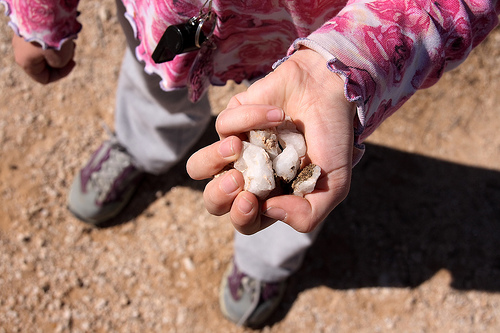
Welcome to Rocks and Minerals of Salt Lake County
. . . a course taught by Dr. Genevieve Atwood founder of Earth Science EducationOur goals for this course and website are:
- Understand the differences between bedrock and sediment.
- Understand the differences between rocks and minerals.
- Practice observation vs. interpretation.
- Know the rock cycle and its four processes and four products.
- Create stories of rocks and minerals as literacy.
Our approach:
Tell stories
Focus on the rock cycle (the plot of the story). De-emphasize knowing all the characters names (rock names). We want you to learn to distinguish only the three major rock types (sedimentary, metamorphic and igneous), to memorize only the five most abundant rock-forming minerals, and to learn the names of only a few rocks, minerals and fossils that are of special importance to Salt Lake County. Earth science is about processes, about the story. We cringe when Rocks and Minerals is taught as boring memorization of the crystal characteristics of a generic rock collection.
The rock story has no beginning and no end.
Every rock tells a story.
The geologic story is written in rocks
Personalize earth science
Children like to learn about their environment, their rocks. Few, if any, places of comparable size in the world offer as outstanding an opportunity to teach rocks and minerals using locations that students can see, visit, and relate directly to their lives as does Salt Lake County.
- Salt Lake County rocks tell stories of every eon of geologic time.
- Children can find the five abundant rock-forming minerals in the common rocks of their school yards or exotic rocks in cemeteries.
- Mining is big business in Salt Lake County from the exploitation of abundant sand and gravel deposits to open-pit mining of distinctive copper and gold-bearing ores from a world-class mining district.
- Local vistas include examples of sedimentary, metamorphic, and igneous bedrock.
- Most schools are constructed on unconsolidated sediments that tell fascinating stories of recent climate change such as the huge lake that drowned much of the valley and glaciers in some canyons.
- Today's streams provide accessible laboratories for studying river processes.
Use the outdoors as your laboratory
"No child left inside!" is our motto. We encourage you to teach earth science outside. We hope this course inspires you to study earth science in more detail. After taking this course you are ready to tackle the vocabulary and concepts of texts such as Dynamic Earth by Brian J. Skinner and Stephen C. Porter.
Colleen Bliss - Web Admin and Designer
last revised 12/5/07
